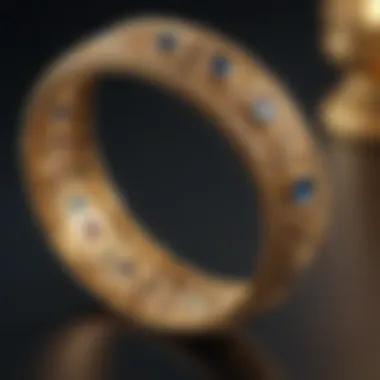Exploring the Distinctions: 10K vs 14K Gold - A Comprehensive Comparison


Overview of Gold Karats
Gold, a precious metal revered for its beauty and value, comes in various karats, with 10K and 14K being popular choices for jewelry. The karat, not to be confused with carat, refers to the purity of gold and is denoted by the number preceding 'K'. In this detailed exploration, we will unravel the disparities between 10K and 14K gold, shedding light on their composition, durability, value, and optimal uses in jewelry crafting.
Composition Variance
At the core of the divergence between 10K and 14K gold lies their composition. 10K gold contains 41.7% pure gold mixed with other metals such as copper, zinc, and nickel. On the other hand, 14K gold boasts a higher purity level of 58.3%, incorporating a larger proportion of pure gold, resulting in a richer color and increased value.
Durability and Wearability
When contemplating jewelry selection, considerations of durability and wearability are paramount. 10K gold, due to its higher percentage of alloyed metals, is more robust and less prone to scratches or tarnishing compared to 14K gold. However, 14K gold with its higher gold content offers a balance between durability and richness, making it ideal for daily wear pieces that require both strength and elegance.
Value Assessment
The value of gold jewelry is multifaceted, encompassing factors beyond purity. While 14K gold holds a higher intrinsic worth due to its increased gold content, 10K gold presents a more affordable option without compromising on aesthetics or durability. Prospective buyers must weigh their priorities between value and quality when selecting between these two gold karats.
Suitability for Jewelry Pieces
The choice of gold karat significantly impacts the aesthetic and longevity of jewelry pieces. 10K gold finds its niche in sturdy designs such as bracelets and chains, offering durability and affordability. Conversely, 14K gold is favored for intricate pieces like engagement rings and pendants, where the balance between elegance and resilience is crucial.
Introduction
In the world of fine jewelry, the debate between 10K and 14K gold is a recurring theme, posing a dilemma for those seeking the perfect balance between durability, value, and aesthetics. Understanding the nuances between these two karatages is paramount for making an informed decision when investing in precious pieces that not only reflect personal style but also stand the test of time.
Brief Overview of Gold Karats
Delving into the realm of gold karats unveils a realm where purity meets alloy, defining the inherent characteristics of each piece. Karat, the universal marker of gold purity, crafts a narrative of sophistication and elegance, distinguishing fine jewelry craftsmanship with its blend of gold and complementary metals.
Definition of Karat
The essence of karat lies in its definitive measure of the gold content within an alloy. Understanding the karat system is key to unraveling the intricate world of gold jewelry, where 24 karats signify pure gold and lower karatages like 10K and 14K represent a fusion of gold with other metals. The allure of the karat scale lies in its ability to convey not just purity but also durability and resilience, making it a crucial element in determining the quality of gold jewelry pieces.
Significance in Jewelry Making
In the realm of jewelry creation, the karatage of gold plays a pivotal role in shaping the final product's aesthetic and functional attributes. Gold's malleability and ductility, when blended with alloys, create a synergy that results in pieces that are not only visually stunning but also durable. The significance of karats in jewelry making extends beyond mere numbers, influencing design choices, gemstone settings, and even the overall wearability of a piece.
Purpose of the Comparison
At the core of comparing 10K and 14K gold lies the intent to empower consumers with knowledge that goes beyond mere aesthetics. This comparison serves as a guide for individuals navigating the intricate world of fine jewelry, offering insights into the quality, value, and long-term satisfaction associated with their investment choices.
Informing Consumer Choices
Empowering consumers with the knowledge to discern between 10K and 14K gold is a crucial aspect of this comparison. By shedding light on the differences in composition, durability, and overall value, this exploration aims to enable individuals to make choices that align with their preferences and lifestyle. Understanding the implications of karatage on a piece's longevity and aesthetics ensures that consumers can make informed decisions that resonate with their unique style.


Quality Assessment
Integral to the comparison of 10K and 14K gold is the critical evaluation of quality markers that define the worth of a piece. Assessing the craftsmanship, durability, and overall value of gold jewelry transcends mere aesthetics; it delves into the core principles of investment in pieces that not only captivate visually but also hold their value over time. Quality assessment, therefore, serves as a guiding light for consumers seeking to strike a balance between exquisite design and inherent value in their precious acquisitions.
Composition
Gold composition plays a pivotal role in the jewelry industry, distinguishing various karats like 10K and 14K. Understanding the composition of gold is essential for both consumers and jewelry makers. It determines the quality, durability, and appearance of the final piece. The proportion of pure gold to alloys is a critical factor in the composition, impacting factors such as strength, color, and value.
10K Gold Composition
When examining 10K gold composition, one must consider the percentage of gold versus alloys. In the case of 10K gold, it consists of 41.7% pure gold and 58.3% alloys, such as silver, copper, and zinc. This lower gold content results in increased strength and durability, making it more suitable for everyday jewelry pieces that may undergo regular wear and tear. However, this blend may also affect the overall appearance and color of the gold, leaning towards a slightly duller hue compared to higher karat gold.
Percentage of Gold vs. Alloys
The percentage of gold versus alloys in 10K gold is crucial for its robustness. By including a higher proportion of alloys, the gold becomes more resistant to scratches and dents, ideal for individuals with an active lifestyle who want their jewelry to withstand daily activities. This composition enhances the longevity of the jewelry, ensuring that it retains its shape and structure over time.
Metal Strength
Another significant aspect of 10K gold composition is its metal strength. The presence of alloys like copper and silver contributes to the overall durability of the gold, making it less susceptible to damage. This increased strength is advantageous for jewelry pieces subjected to frequent use, as it minimizes the risk of bending or warping. However, the trade-off for this strength is a slightly lower gold content, affecting the perceived value and shine of the jewelry.
14K Gold Composition
In contrast, 14K gold boasts a higher gold content of 58.3% and alloy composition of 41.7%. This results in a higher purity level compared to 10K gold. The alloys used in 14K gold vary slightly, with common additions like copper, silver, and zinc. The increased gold content contributes to a richer color and shine, closer to that of 24K gold, while still retaining sufficient strength for regular wear.
Different Alloy Composition
The specific mix of alloys in 14K gold impacts its characteristics. The inclusion of metals like copper can add warmth to the gold's tone, creating a classic look that is popular in traditional jewelry designs. These alloys also enhance the malleability of the gold, allowing intricate detailing and designs to be incorporated into the jewelry.
Gold Purity Levels
Gold purity levels refer to the amount of pure gold present in the alloy. In 14K gold, the higher gold content increases the perceived value of the jewelry while offering a balance between purity and durability. This purity level makes 14K gold suitable for a wide range of jewelry pieces, from everyday accessories to special occasion adornments. However, the higher gold content may make 14K jewelry slightly softer and more prone to scratching than its 10K counterpart.
Durability and Wearability
In the realm of jewelry-making, understanding the durability and wearability of different gold types is paramount. This section delves into the specifics of how 10K and 14K gold fare in terms of longevity and everyday use. By comprehensively analyzing these aspects, consumers can make more informed decisions when selecting their desired gold karat.
10K Gold Durability
Resistant to Tarnishing
When scrutinizing the durability of 10K gold, one notable advantage is its resistance to tarnishing. This unique property ensures that 10K gold pieces maintain their luster and shine even after prolonged wear. The ability of 10K gold to resist tarnishing makes it a popular choice for individuals seeking low-maintenance jewelry options that stand the test of time. Despite its durability in this aspect, some may find that 10K gold lacks the higher purity levels associated with 14K gold, which can influence its overall appearance over time.
Ideal for Daily Wear
Another compelling facet of 10K gold is its suitability for daily wear. Its robust composition makes it ideal for pieces that are worn regularly without the risk of significant damage. Jewelry pieces crafted from 10K gold can withstand the rigors of daily activities, making them a practical choice for individuals looking for both durability and affordability in their jewelry selections. While 10K gold's resilience is admirable, it's essential to note that its alloy composition may make it slightly less malleable compared to higher gold karats, potentially affecting intricate designs.


14K Gold Durability
Balanced Durability and Purity
In contrast, 14K gold offers a harmonious balance between durability and purity. This balance allows for a resilient metal that also exudes a higher gold content than 10K gold. The combination of durability and increased gold purity renders 14K gold as an attractive choice for individuals seeking both longevity and a more refined appearance in their jewelry pieces. While 14K gold may show signs of wear over time, its higher gold content contributes to a recognizable sheen that is prized by many jewelry enthusiasts.
Suitable for Occasional Wear
14K gold's durability makes it suitable for occasional wear, where pieces are worn selectively for special occasions. The balance between durability and gold purity in 14K gold ensures that these pieces can withstand occasional wear without losing their allure. While 14K gold boasts a higher gold content than 10K gold, it may still exhibit minor signs of wear upon frequent use due to its softer composition. This characteristic makes 14K gold a preferred choice for individuals who value elegance and longevity in their occasional jewelry selections.
Value and Pricing
Value and Pricing are pivotal considerations in this article, offering vital insights into the economic aspects of 10K and 14K gold. Understanding the value of gold in jewelry-making is fundamental for consumers making informed decisions regarding their purchases. The pricing of gold jewelry is influenced by various factors, including market trends, craftsmanship, and purity levels. By delving into the intricacies of value and pricing, readers can gain a deeper appreciation for the monetary aspects associated with owning gold jewelry.
Factors Affecting Value
Gold Content
Gold content plays a crucial role in determining the overall value of gold jewelry. The purity of gold is measured in karats, with 24K being the purest. Lower karats like 10K and 14K indicate a higher proportion of alloy metals mixed with gold, affecting both value and durability. While 10K gold contains 41.7% pure gold, 14K gold has 58.3% pure gold. This difference in gold content directly impacts the value of the jewelry, with higher gold content usually correlating to higher prices. Consumers opting for higher karat gold pieces are investing in greater purity and consequently, higher financial value.
Market Demand
Market demand is another key determinant of gold jewelry pricing. The fluctuations in supply and demand directly influence the market value of gold. Variations in consumer preferences, trends, and economic conditions can impact the demand for specific karat gold jewelry. For instance, if 14K gold jewelry is in high demand due to fashion trends or cultural influences, its price may increase compared to 10K jewelry. Market demand also reflects societal perceptions of value, making it essential for consumers to consider these factors when assessing the pricing of gold jewelry.
Pricing Considerations
Cost Comparison
Cost comparison involves evaluating the price differentials between 10K and 14K gold jewelry. While 10K gold is generally more affordable due to its lower gold content, 14K gold comes at a higher price point due to its increased purity. Factors like craftsmanship, brand reputation, and additional gemstone embellishments can further contribute to price disparities between the two types of gold. Consumers must weigh the cost implications against their desired level of gold purity to make well-informed purchasing decisions.
Long-Term Investment Potential
The long-term investment potential of gold jewelry is an essential consideration for buyers looking to purchase pieces that retain or appreciate in value over time. Higher karat gold, such as 14K, is often perceived as a more secure investment due to its higher gold content. While initial costs may be higher for 14K jewelry, its potential for long-term value retention can outweigh the price disparity with 10K gold. Understanding the investment potential of gold jewelry can guide consumers towards selecting pieces that align with their financial goals and aesthetic preferences.
Aesthetics and Appearance
In the domain of jewelry, aesthetics and appearance play a pivotal role, defining the allure and desirability of a piece. In the comparison between 10K and 14K gold, aesthetics and appearance stand as crucial factors guiding consumer preferences and choices. The unique visual characteristics of each gold karat can significantly impact how a piece is perceived and valued. Understanding the nuances of aesthetics and appearance in gold jewelry is essential for making informed decisions when selecting the ideal piece for one's collection.
Physical Appearance
Color Hue
Color hue holds a critical position in determining the overall visual appeal of a piece of gold jewelry. The distinct color tones of 10K and 14K gold offer varied aesthetics, catering to different tastes and styles. The color hue in 10K gold tends to exhibit a slightly paler tone compared to the richer and more vibrant hue of 14K gold. This variation in color hue allows individuals to choose between a subtler or more pronounced gold appearance based on personal preferences. While the paler hue of 10K gold may complement certain gemstones or designs, the luster of 14K gold can enhance the brilliance of gemstones and elevate the overall look of the jewelry piece.


Luster
Luster, the reflective quality of a metal surface, significantly contributes to the visual impact of gold jewelry. The luster of 10K gold leans towards a more understated and subtle shine, reflecting a sophisticated elegance. In contrast, the luster of 14K gold is known for its vibrant sheen and brilliance, exuding a luxurious charm. This stark difference in luster between the two gold karats allows individuals to select a piece based on their preference for a subdued or striking appearance. While the understated luster of 10K gold may appeal to those seeking a demure elegance, the radiant luster of 14K gold can create a statement piece that catches the eye and exudes opulence.
Jewelry Design Considerations
Compatibility
The compatibility of gold with different gemstones and designs is a crucial aspect to consider when selecting the ideal gold karat for a jewelry piece. 10K gold, with its subtle color hue and understated luster, exhibits excellent compatibility with a wide range of gemstones, from vibrant colored stones to diamonds, accentuating their beauty with its elegant backdrop. On the other hand, 14K gold's rich color hue and striking luster make it a perfect match for gemstones that benefit from a complementary contrast, such as sapphires or rubies. By understanding the compatibility of each gold karat with various gemstones, individuals can create harmonious and visually appealing jewelry designs that reflect their unique style and preferences.
Design Versatility
The design versatility offered by different gold karats is a key consideration when conceptualizing and creating jewelry pieces. 10K gold's subtle color tone and understated luster lend themselves well to versatile designs that can seamlessly transition from everyday wear to special occasions. Its versatility allows for the creation of classic and timeless jewelry pieces that exude sophistication. In contrast, 14K gold's rich color hue and vibrant luster open doors to more elaborate and intricate designs that demand attention and admiration. The design versatility of 14K gold enables the crafting of statement pieces that captivate with their opulent aesthetics and luxurious appeal.
Suitability for Different Jewelry Types
In this section, we delve into the critical aspect of the suitability of 10K and 14K gold for various jewelry types. Understanding the appropriate use of each karatage is key in making informed decisions about your jewelry purchase. The choice between 10K and 14K gold can significantly impact the durability, appearance, and value of your jewelry pieces. By exploring the suitability for different jewelry types, we aim to provide valuable insights into selecting the right karatage for your specific needs.
10K Gold Usage
Popular Jewelry Pieces
When it comes to popular jewelry pieces, 10K gold stands out for its versatility and affordability. Pieces such as simple chains, everyday rings, and casual bracelets are commonly crafted using 10K gold due to its durability and resilience to daily wear. The key advantage of using 10K gold in these pieces is its ability to withstand frequent use without losing its shine or shape. While 10K gold may lack the high purity levels of 14K gold, its strength and practicality make it an excellent choice for those seeking quality pieces for everyday wear.
Compatible Gemstones
In terms of compatible gemstones, 10K gold complements a range of colorful and semi-precious stones. Gemstones like garnet, citrine, topaz, and amethyst pair beautifully with the warm tones of 10K gold, creating vibrant and eye-catching jewelry pieces. The affordability of 10K gold also makes it a popular choice for setting multiple gemstones in a single piece without compromising on quality. By exploring the compatibility of gemstones with 10K gold, we uncover exciting possibilities for creating unique and personalized jewelry styles.
14K Gold Application
Preferred Jewelry Types
14K gold is often preferred for elegant and formal jewelry pieces such as engagement rings, necklaces, and sophisticated earrings. The key characteristic of 14K gold is its perfect balance between durability and purity. Jewelry designs that require intricate detailing or gemstone settings can benefit from the malleability of 14K gold without compromising on quality. The versatility of 14K gold in creating intricate designs makes it a sought-after choice for those looking to invest in timeless and refined jewelry pieces.
Gemstone Pairing
When it comes to gemstone pairing, 14K gold offers a luxurious backdrop for a wide range of precious stones such as diamonds, sapphires, rubies, and emeralds. The rich color and subtle luster of 14K gold enhance the brilliance of these gemstones, creating a sophisticated and upscale look. The unique feature of 14K gold lies in its ability to elevate the beauty and value of high-end gemstones, making it a popular choice for statement jewelry pieces. By exploring the art of gemstone pairing with 14K gold, we unveil the endless possibilities for creating exquisite and luxurious jewelry collections.
Conclusion
In unraveling the disparities between 10-karat and 14-karat gold, it becomes evident that choosing the right gold for your jewelry pieces is a decision that goes beyond mere aesthetics. The composition, durability, value, and suitability for different jewelry types all play crucial roles in the selection process. Understanding the nuances between these two gold variants aids consumers in making informed decisions that align with their preferences and requirements. Whether seeking long-term investment potential or daily wear jewelry, the conclusion serves as a compass guiding buyers towards the most suitable choice for their needs.
Key Takeaways
Choosing the Right Gold for Your Needs
Diving deep into the facet of choosing the right gold for your needs reveals a fundamental aspect of jewelry selection. The intrinsic characteristics of 10K and 14K gold influence their application in diverse jewelry pieces, with each karat offering distinct qualities. Whether prioritizing durability for frequent wear or a balanced blend of purity and strength, the choice between 10K and 14K gold hinges on personal preferences and intended usage. Understanding the implications of selecting the appropriate karat underscores the importance of aligning the gold composition with the desired jewelry piece, ensuring longevity and satisfaction in adornment.
Balancing Quality and Affordability
The delicate equilibrium between quality and affordability is a pivotal consideration when comparing 10K versus 14K gold. Balancing the purity of gold with its durability and pricing reflects the careful thought required in jewelry acquisition. While 14K gold boasts higher purity, 10K gold shines for its affordability and strength, offering a spectrum of options for consumers with varied budgets and preferences. Navigating this equilibrium forms the essence of wise jewelry selection, where considerations of value, longevity, and visual appeal merge to form a harmonious choice that satisfies both quality standards and budget constraints.







